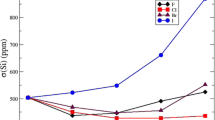Abstract
We have calculated the components of the paramagnetic part of the magnetic shielding tensor for nuclei in molecules of LiH, HF, and H2O within the uncoupled variant of Hartree-Fock-Roothaan perturbation theory, taking into account the dependence of the original basis set of Slater-type AO's (STO's) on the perturbation parameter. We have shown that it is necessary to take into account such a dependence when calculating the components of the magnetic shielding tensor in minimal basis sets of STO's. We have carried out a comparative analysis of the data obtained with results of other approaches.
Similar content being viewed by others
Literature cited
R. M. Stevens, R. M. Pitzer, and W. N. Lipscomb, “Perturbed Hartree-Fock calculation. 1. Magnetic susceptibility and shielding in the LiH molecule,” J. Chem. Phys., 38, No. 2, 550–560 (1963).
P. Lazzeretti and R. Zanasi, “Calculations of the magnetic shielding constants of heavy nuclei in polyatomic molecules,” Int. J. Quant. Chem., 12, No. 1. 93–103 (1977).
P. Lazzeretti and R. Zanasi, “Calculations of proton magnetic snielding constants in polyatomic molecules,” J. Chem. Phys., 68, No. 3, 832–839 (1978).
P. Lazzeretti and R. Zanasi, “Electric and magnetic nuclear shielding tensors. A study of the water molecule,” Phys. Rev. A, 33, No. 6, 3727–3741 (1986).
R. Höller and H. Lischka, “Coupled Hartree-Fock calculations of susceptibilities and magnetic shielding constants, 1,” Mol. Phys., 41, No. 5, 1017–1040 (1980).
R. Ditchfield, “Self-consistent perturbation theory of diamagnetism. 1. A gauge-invariant LCAO-method for NMR chemical shifts,” Mol. Phys., 27, No. 4, 789–807 (1974).
T. K. Rebane, “Magnetic properties of molecules with closed electron shells,” in: Con-temporary Problems in Quantum Chemistry. Structure and Properties of Molecules [in Russian], Nauka, Leningrad (1986), pp. 165–211.
R. M. Aminova, “Calculation of nuclear magnetic shielding with ab initio wave functions,” Khim. Fiz., 3, No. 9, 1240–1244 (1984).
R. M. Aminova, N. I. Zoroatskaya, and Yu. Yu. Samitov, “Calculation of nuclear magnetic shielding constants by the method of gauge-invariant atomic orbitals using Gaussian functions,” J. Magn. Reson., 33, 497–503 (1979).
P. V. Schastnev and A. A. Cheremisin, “Quantum chemical calculations of NMR chemical shifts,” Zh. Strukt. Khim., 23, No. 3, 139–170 (1982).
A. Saika, “Many-body perturbation study of electron correlation effects on NMR parameters,” Bull. Magn. Reson., 7, No. 2/3, 100–104 (1985).
E. O. Voronkov and V. V. Rossikhin, “Derivatives of the bond order matrix for a perturbation parameter-dependent basis in calculations of the physical properties of molecules,” Teor. Éksp. Khim., 17, No. 5, 669–674 (1981).
M. M. Mestechkin, Density Matrix Method in Molecular Theory [in Russian], Nauk. Dumka, Kiev (1977).
E. O. Voronkov and V. V. Rossikhin, “dSolution of the inhomogeneous Schrbödinger equation with a model pseudopotential,” Teor. Mat. Fiz., 48, No. 1, 121–128 (1981).
M. S. Borisovand, S. I. Vetchinkin, “Application of perturbation theory to calculation of the diamagnetic susceptibility of ten-electron systems,” Teor. Éksp. Khim., 6, No. 2, 168–173 (1970).
R. M. Pitzer and D. P. Merrifield, “Minimum basis wave functions for water,” J. Chem.Phys., 52, No. 9, 4782–4787 (1970).
B. J. Ransil, “Studies in molecular structure. 2. LCAO-MO-SCF wave functions for selected first-row diatomic molecules,” Rev. Mod. Phys., 32, No. 2, 245–254 (1962).
D. Zeroka and H. F. Hameka, “Calculations of magnetic shielding constants of diatomic molecules. 1. General theory and applications to the HF molecule,” J. Chem. Phys., 45, No. 1, 300–311 (1966).
Author information
Authors and Affiliations
Additional information
Translated from Teoreticheskaya i Éksperimental'naya Khimiya, Vol. 24, No. 5, pp. 527–532, September–October, 1988
Rights and permissions
About this article
Cite this article
Voronkov, E.O., Kuz'menko, V.V. & Rossikhin, V.V. Effect of perturbation of the atomic basis on nuclear magnetic shielding constants for small molecules. Theor Exp Chem 24, 511–515 (1989). https://doi.org/10.1007/BF00534415
Received:
Issue Date:
DOI: https://doi.org/10.1007/BF00534415




